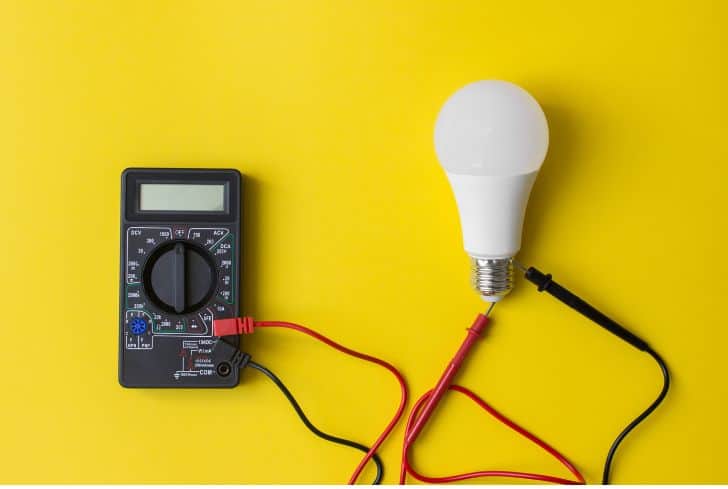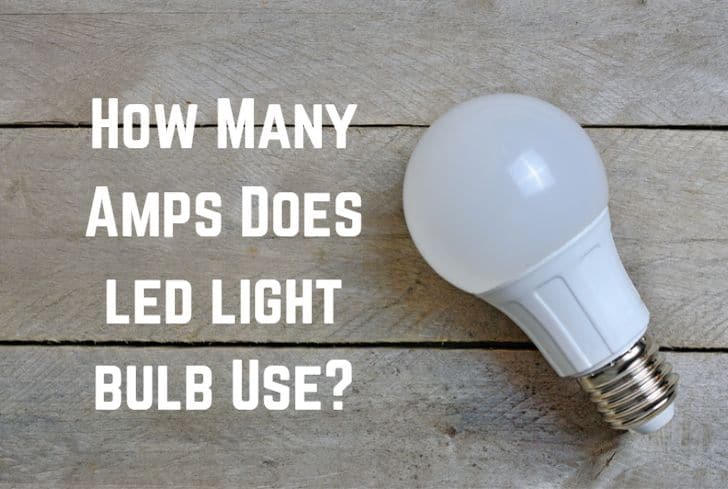Long-lasting, energy-efficient, environmentally friendly, and that’s not all. We’ve got a plethora of reasons to ditch those pesky old-fashioned light bulbs and switch to LEDs. But before we do, one big question remains: How many amps does an LED light bulb draw?
Well, this is a frequently asked question by homeowners who are considering making the switch to LEDs. And today, I’ll discuss all there’s to know about the amperage draw of LED light bulbs. So, if it’s the same question on your mind, read on!
Read: How Many Amps Does an Electric Oven Use?
How Many Amps Does a LED Light Bulb Use?
The number of amps that an LED light draws depends on the wattage of the bulb and the voltage of your home’s electrical system. On average, 9W and 15W LED light bulbs will use 0.075A and 0.125A, respectively. But generally, LED lights use up to 80% less power than traditional incandescent bulbs, meaning their amperage draw is much lower than their traditional counterparts.
Incandescent bulbs have served us well for many years. However, with the current dynamics of the energy market and the ever-growing concerns over climate change, it’s time to start looking for more energy-efficient alternatives. And that’s where LED light bulbs come in.
We’ve all heard all the hype about these latter-day light bulbs. They’re said to be up to 10 times more durable, much safer, better for the environment, and more energy efficient. And undoubtedly, they are.
The table below shows the number of amps different wattage LED bulbs draw at 120 and 220 volts and put the numbers in a table.
| LED Bulb Wattage | Amperage at 120V | Amperage at 220V |
| 9W | 0.075A | 0.041A |
| 10W | 0.083A | 0.045A |
| 15W | 0.125A | 0.068A |
| 20W | 0.167A | 0.091A |
| 25W | 0.208A | 0.114A |
| 40W | 0.333A | 0.182A |
| 50W | 0.417A | 0.227A |
| 60W | 0.5A | 0.273A |
| 80W | 0.667A | 0.364A |
| 100W | 0.833A | 0.455A |
| 150W | 1.25A | 0.682A |
| 200W | 1.667A | 0.909A |
| 250W | 2.083A | 1.136A |
| 400W | 3.333A | 1.818A |
As you may have noticed, the relationship between the amperage and voltage is an alternating one. In other words, as you increase the voltage, the amperage draw decreases, and vice versa. This is because, at higher voltages, less current is required to produce the same amount of power.
But again, sometimes, the wattage labeling on some LED bulbs can be tricky to understand. That’s because some bulbs are rated in equivalence to traditional incandescent bulbs, while others are rated in actual wattage.
For example, an equivalence rating of 60 watts on an LED light bulb actually means that it will produce the same amount of light as a 60-watt incandescent bulb. However, the actual wattage of the LED bulb would be much lower, probably around 8 watts.
Usually, the actual LED wattage ranges between 3 and 17 watts. Once you notice a higher wattage, check whether the equivalence rating could be in play. So yes, sometimes calculating the amperage draw of your bulb isn’t as easy as picking what’s indicated on the bulb and plugging it into the formula.
But in any case, one thing is certain: the amperage draw of LED light bulbs is significantly lower than that of their traditional counterparts.
How Many Amps Do 12 Volt Led Lights Draw?
The amps that 12-volt LED lights draw will depend on the wattage of the bulb. But generally, comparing a 12-volt bulb to one that uses a standard 120-volt household current, the 12-volt bulb will have to draw more amperes to produce the same amount of light.

You see, voltage is an essential component when determining the amperage draw of an appliance. And usually, the higher the voltage, the fewer amperes an appliance will need to draw from the power source.
That’s because, with a higher voltage, electrons are “pumped” at a higher rate, so a lower number of amperes will still be adequate to meet the electrical needs of an appliance. But as the voltage decreases, the amperes must increase to compensate for the lower voltage.
For example, a 60-watt incandescent light bulb running on 120 volts will have an amperage draw of 0.5 amperes. But if you have a 12-volt LED light with the same wattage, it will need to draw 5 amperes to produce the same light intensity.
So, to calculate the amperage draw of a 12-volt LED light, get the wattage, and divide it by 12. It will give you a reasonable estimate of how much current the bulb will need. Usually, the higher the wattage, the higher the amperage draw.
How Many Amps Does a Lamp Use?
The number of amps that a lamp uses again varies depending on the wattage of the lamp and the voltage of your electrical system. Assuming you have two 60-watt bulbs, they should draw an ampere if you use a 120-volt system. That’s half an ampere for each light bulb.
But if you’re using a 240-volt system, the number of amps each light bulb draws will also be halved. In other words, each light bulb will draw a quarter of an ampere from the power source. That’s half an amp for the two bulbs, just half of what they would need if you used a 120-volt system.
Of course, this is all under the assumption that we’re talking about incandescent bulbs. If you’re using LED bulbs, the amperage draw will be lower as these bulbs are more efficient. Most LED bulbs will have an amperage draw of around 0.2 to 0.6 amps at 120 volts.
How To Calculate Amps For LED Lights?
You can calculate the amperage draw of your LED lights by dividing the actual wattage of the bulb by the voltage of your electrical system. But again, check to ensure that the indicated wattage isn’t an equivalent rating for traditional incandescent bulbs.
You don’t use any new formula to determine how many amps LED lights draw. You only need to know the bulb’s wattage and the voltage; from there, you can divide to get the number of amps.
For example, if you have an 8-watt LED light bulb running on a 120-volt electrical system, the amperage draw would be 8 watts divided by 120 volts which equals 0.0667 amps.
But if you have the same 8-watt LED bulb running on a 240-volt electrical system, the amperage draw would be 8 watts divided by 240 volts, which equals 0.0333 amps.

How Many Amps Does a 1000w LED Use?
Technically, a 1000-watt LED light uses 8.33 amps when running on a 120-volt electrical system and 4.17 amps at 240 volts. But then again, check to see if the bulb is actually 1000 watts or just equivalent to a 1000-watt traditional bulb.
Most of the wattage used by incandescent bulbs goes into generating heat. Actually, only less than 5% of the energy they draw goes into producing light. But for LED bulbs, they utilize a technology that’s called solid-state lighting.
In this technology, the electricity is converted into light more efficiently. No heat production here, so everything the bulb draws goes into illumination. That explains why you only need a low-wattage LED to generate the same light intensity as a high-wattage incandescent bulb.
And generally speaking, a 1000-watt LED light is way too bright than what you need for indoor use. We’re talking about over a hundred thousand lumens of light here. That’s too much, considering indoor needs about 1000 to 4000 lumens.
But that’s not to say that there aren’t any circumstances in which you would need such a bright light. If you’re using it outdoors or in an industrial setting, 1000 watts might be just what you need.
Read: How Many Amps Does a Phone Charger Use?
How Many LEDs Can Be on a 20 Amp Circuit?
The number of LEDs you can use on a 20-amp circuit will depend on the wattage of your LEDs. If using low-wattage LEDs, you can have more on the circuit. But if working with high-wattage LEDs, you’ll need to use fewer.
But as set by the National Electric Code, a circuit should only carry up to 80% of its capacity. The 20% is left to serve as a buffer against any sudden spikes in demand, such as higher energy demand during start-ups.
So, assuming you have a 20-amp circuit and a 120-volt electrical system, the maximum it can support is 2400 watts. And since we’re only supposed to use 80% of that, the circuit should only carry loads up to 1920 watts.
Now, if you’re using a 50-watt LED, that would mean that you can only have 38 of them before you reach the safety limit. But if you’re using a 65-watt LED, you can only have 29.

Use the same formula to calculate the number of LEDs you can use in your 15-amp breaker. But here, remember to use 1440 watts as your maximum capacity since we’re only supposed to use 80% of the circuit’s capacity.
The YouTube video below shows how to calculate the LEDs for 15-amp and 20-amp circuits.
Do LED Lights Draw More Amps Than Traditional Incandescent Bulbs?
The answer to this question is no. LED lights are more energy efficient and will produce an equivalent amount of light to incandescent bulbs, albeit using less watts. The less number of watts translates to lower amps required for LED bulbs.
However, there is a slight difference in how each type draws electricity. An incandescent bulb will have a higher amperage draw when first turned on. That’s because it takes some time for the filament inside the bulb to heat up and produce light.
In LED bulbs, there is no filament. Instead, the electricity is directly converted into light. So, there is no initial surge in amperage draw when first turned on.
To summarize, an LED bulb will have a lower wattage and use less electricity than an incandescent bulb assuming the two have the same voltage power source. The LED bulb will also have a lower amperage draw than the incandescent bulb.
Read: How Many Amps Does a Garbage Disposal Use?
Final Verdict
The amount of amps an LED bulb draws is lower than an incandescent bulb. But more precisely, the amperage draw depends on the specs of the LED bulb, such as wattage and the voltage of the power source.
With these two factors, you can calculate the amperage draw of an LED bulb. Only remember that sometimes the specified wattage on LED bulbs doesn’t always reflect the actual wattage draw.






